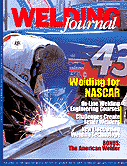Dirt Every Day Motorhome Go-Kart
Not a motorcycle.. BUT:
Friday, April 11, 2014
Wednesday, April 9, 2014
Welding 4130 Chrome Moly Steel for Race Cars
Welding 4130 Chrome Moly Steel for Race Cars:
Welding 4130 Chrome Moly Steel for Race Cars During the WW II era 4130 high strength steel was used for some aircraft components. At that time oxy-acetylene was the welding process of choice for many of these items. The preheat and slow cooling inherent with that process made welding the nominal 0.30 carbon steel relatively straight forward (assuming one could oxyacetylene weld!). However with more modern welding process like TIG and MIG, the cooling rates can be much faster and care must be taken to avoid forming high hardness and brittle Martensite on cooling transformation. On heavier sections preheat and post weld heat treatment should be used. With the proper post weld heat treatment strengths of 200,000 psi can be achieved with reasonable toughness by tempering the Martensite that forms in the heat treating process. However when welding race car tubing, preheat is not often used nor are the parts post weld heat treated. During the WW II era 4130 high strength steel was used for some aircraft components. At that time oxy-acetylene was the welding process of choice for many of these items. The preheat and slow cooling inherent with that process made welding the nominal 0.30 carbon steel relatively straight forward (assuming one could oxyacetylene weld!). However with more modern welding process like TIG and MIG, the cooling rates can be much faster and care must be taken to avoid forming high hardness and brittle Martensite on cooling transformation. On heavier sections preheat and post weld heat treatment should be used. With the proper post weld heat treatment strengths of 200,000 psi can be achieved with reasonable toughness by tempering the Martensite that forms in the heat treating process. However when welding race car tubing, preheat is not often used nor are the parts post weld heat treated.
Most of the tubing used for race car construction is referred to as normalized. This refers to the heat treatment and cooling rate the tubing was subjected to in manufacture. Most normalized tubing will range in tensile strength from 95,000 to 110,000 psi. This can be welded with the proper filler metals to achieve similar strengths. Although there are more weldable grades of steel (those with lower carbon content from 0.06 to 0.15) in the 100,000 to 115,000 psi tensile strength range readily available for plate and sheet, 4130 remains a commonly used grade for tubing. Just be sure to take the precautions noted when welding.
The following is extracted from an article I wrote for the American Welding Societies technical journal called "The Welding Journal". It has additional information to that presented in the publication. You can Click This Link to see the article:
|
PROPER FILLER METAL CHOICE FOR WELDING 4130 In the mid 1970’s, while managing an R&D group for a leading welding shielding gas/filler metals manufacturer, a phone call was received from a dragster chassis builder. They wanted to weld 4130 tubing and needed a filler metal suggestion. Being a “car buff,” a number of alternatives were considered to provide the optimum solution. After careful review of their requirements and desired welding practices, the solution was defined. They were welding 4130 normalized tubing, it would not be heat treated after welding, preheat was not desirable and most of the weld joints were intersecting tubes that required fillet welds. The best filler material to use was a low carbon alloy now called ESAB Spoolarc 65 (meeting an American Welding Society (AWS) ER70S-2 specification). The main objective is to produce porosity and crack free weld deposits. In the mid 1970’s, while managing an R&D group for a leading welding shielding gas/filler metals manufacturer, a phone call was received from a dragster chassis builder. They wanted to weld 4130 tubing and needed a filler metal suggestion. Being a “car buff,” a number of alternatives were considered to provide the optimum solution. After careful review of their requirements and desired welding practices, the solution was defined. They were welding 4130 normalized tubing, it would not be heat treated after welding, preheat was not desirable and most of the weld joints were intersecting tubes that required fillet welds. The best filler material to use was a low carbon alloy now called ESAB Spoolarc 65 (meeting an American Welding Society (AWS) ER70S-2 specification). The main objective is to produce porosity and crack free weld deposits. |
Tuesday, April 8, 2014
Monday, April 7, 2014
Sunday, April 6, 2014
Subscribe to:
Posts
(
Atom
)












